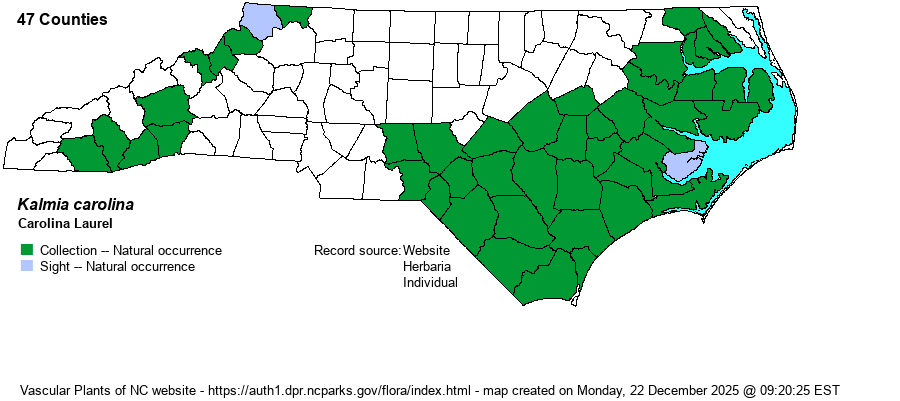| Section 6 » Order Ericales » Family Ericaceae |
Show/Hide Synonym
| taxonName | relationship | relatedTaxonName | relatedTaxonRefText | relComments |
|---|
|
|
|
|
|
|
| Kalmia carolina | = | Kalmia angustifolia var. caroliniana | Radford, Ahles, and Bell (1968) | , orthographic error | | Kalmia carolina | = | Kalmia angustifolia var. caroliniana | | , orthographic error | | Kalmia carolina | = | Kalmia angustifolia var. carolina | Gleason and Cronquist (1991) | | | Kalmia carolina | = | Kalmia angustifolia var. carolina | Fernald (1950) | | | Kalmia carolina | = | Kalmia angustifolia var. carolina | Flora of North America (1993b, 1997, 2000, 2002a, 2002b, 2003a, 2004b, 2005, 2006a, 2006b, 2006c, 2007a, 2009, 2010) | | | Kalmia carolina | = | Kalmia angustifolia var. carolina | Gleason (1952) | | | Kalmia carolina | = | Kalmia angustifolia var. carolina | | | | Kalmia carolina | = | Kalmia angustifolia var. carolina | Stevens et al. in Kubitzki (2004). | | | Kalmia carolina | = | Kalmia angustifolia ssp. carolina | Stevens et al. in Kubitzki (2004). | | | Source: Weakley's Flora |
|
| Author | Small | |
| Distribution | This recently split species, from K. angustifolia, has a strongly bimodal distribution in both the state and its overall range. In NC, it occurs nearly throughout the Coastal Plain, and also occurs over much of the Mountains. It appears to be absent from the northwestern Coastal Plain and probably all of the Piedmont. It likely is absent from scattered mountain counties, as well.
This species is the southern taxon of the greater “Sheep Laurel” species, being found from southeastern VA south in the Coastal Plain only to GA (very rare), and in the mountains from southwestern VA to northeastern GA; it is very rare in TN.
| |
| Abundance | Frequent to locally common over most of the Coastal Plain, except in the northwestern counties, where absent. It is less numerous in the northern half of the Coastal Plain than in the Sandhills and eastward into the southeastern counties. In the Mountains, however, it is generally uncommon and local, and restricted in its habitats. | |
| Habitat | In the Coastal Plain, it favors drier ecotones of pocosins and bay forests, and in pine flatwoods – in acidic soils. It grows best in moist sandy soils in these acidic forests, usually under a pine canopy. In the Mountains, it typically occurs in bogs and rarely in fens. It may occur in wet seepages, and occasionally in exposed rocky places. | |
| Phenology | Blooms mainly in April and May, and again in fall (but less frequently then); fruits in September and October. Blooming in fall is usually in response to fire in the spring or summer. | |
| Identification | This low evergreen shrub, which can occur in extensive colonies, normally grows 2-4 feet tall, but it can reach about 6 feet tall. The leaves are conspicuously glaucous pale blue-green. The lower surface of the thick and leathery, entire, elliptical to oblong leaves of this species is somewhat pubescent; K. angustifolia leaves are mostly glabrous below. See Kalmia angustifolia for additional characters. The two species both occur in Gates and Chowan counties, though it is not certain if K. carolina grows on the Chowan Sand Banks with K. angustifolia. Certainly, away from those two counties, observers should have little trouble identifying this distinctive species, which has showy clusters of rosy-pink flowers. | |
| Taxonomic Comments | Formerly it was considered as a variety of Kalmia angustifolia – i.e., Kalmia angustifolia var. carolina; however, nearly all recent references now afford it full species status.
| |
| Other Common Name(s) | Southern Sheepkill is often used, as a comparison with Northern Sheepkill [K. angustifolia]. Carolina Wicky and Carolina Bog Myrtle are occasionally used. | |
| State Rank | S4 [S5] | |
| Global Rank | G4 [G5] | |
| State Status | | |
| US Status | | |
| USACE-agcp | FACW link |
| USACE-emp | FAC link |

